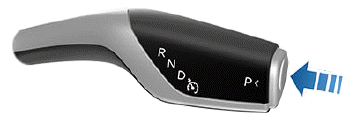Tesla Model Y: Parking Brake
To engage the parking brake, touch Controls > Safety > Parking Brake. Follow the onscreen instructions. You can also engage the parking brake by pressing and holding the button on the end of the drive stalk while in Park.

Use the touchscreen to manually release the parking brake (which also shifts Model Y into Neutral):
1. Touch Controls > Safety.
2. Press the brake pedal, then touch Parking Brake. If Model Y was previously in Park, it shifts into Neutral.
 When you manually apply the parking
brake using the touchscreen, or by pressing and holding the button on the end of
the drive stalk when in Park, the red parking brake indicator lights up on the
touchscreen.
When you manually apply the parking
brake using the touchscreen, or by pressing and holding the button on the end of
the drive stalk when in Park, the red parking brake indicator lights up on the
touchscreen.
 If the parking brake experiences an
electrical issue, the amber parking brake indicator lights up and a fault
message displays on the touchscreen.
If the parking brake experiences an
electrical issue, the amber parking brake indicator lights up and a fault
message displays on the touchscreen.
NOTE: The parking brake operates on the rear wheels only, and is independent of the pedal-operated brake system.
CAUTION: In the unlikely event that Model Y loses electrical power, you cannot access the touchscreen and are therefore unable to release the parking brake without first jump starting Model Y (see Instructions for Transporters).
WARNING: In snowy or icy conditions the rear wheels may not have sufficient traction to prevent Model Y from sliding down a slope, particularly if not using winter tires. Avoid parking on hills in snowy or icy conditions. You are always responsible for parking safely.
WARNING: Your Model Y may display an alert if the road is too steep to safely park on, or if the parking brakes are not properly engaged. These alerts are for guidance purposes only and are not a substitute for the driver's judgment of safe parking conditions, including specific road or weather conditions. Do not depend on these alerts to determine whether or not it is safe to park at any location. You are always responsible for parking safely.
Brake Wear
Model Y brake pads are equipped with wear indicators. A wear indicator is a thin metal strip attached to the brake pad that squeals as it rubs against the rotor when the pad wears down. This squealing sound indicates that the brake pads have reached the end of their service life and require replacement. To replace the brake pads, contact Tesla Service.
Brakes must be periodically inspected visually by removing the tire and wheel. For detailed specifications and service limits for rotors and brake pads, see Subsystems. Additionally, Tesla recommends cleaning and lubricating the brake calipers every year or 12,500 miles (20,000 km) if in an area where roads are salted during winter months.
WARNING: Neglecting to replace worn brake pads damages the braking system and can result in a braking hazard.

